Cochrane, Alberta 作者: 来源: 发布时间:2021-12-06
I.Population and Area
-Area
Land: 29.83 km2 (11.52 sq mi)
-Population (2016)
-Total:25,853
-Density: 866.7/km2 (2,245/sq mi)
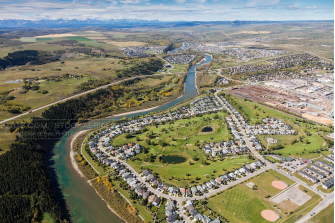
II.Natural Geography (environment and resources)
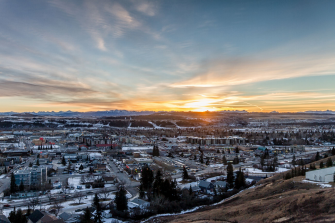
-Cochrane /ˈkɒkrən/ is a town in the Canadian province of Alberta. The town is located 18 km (11 mi) west of the Calgary city limits along Highway 1A. Cochrane is one of the fastest growing communities in Canada, and with a population of 29,277 in 2019, it is one of the largest towns in Alberta. It is part of Calgary's census metropolitan area and a member community of the Calgary Metropolitan Region Board (CMRB). The town is surrounded by Rocky View County.
-The population of the Town of Cochrane according to its 2019 municipal census is 29,277, a change of 4.7% from its 2018 municipal census population of 27,960. At its current population, Cochrane is one of the largest towns in the province and is eligible for city status. According to Alberta's Municipal Government Act, a town is eligible for city status when it reaches 10,000 residents.
-In the 2016 Census of Population conducted by Statistics Canada, the Town of Cochrane recorded a population of 25,853 living in 9,757 of its 10,225 total private dwellings, a 47.1% change from its 2011 population of 17,580. With a land area of 29.83 km2 (11.52 sq mi), it had a population density of 866.7/km2 (2,244.7/sq mi) in 2016.
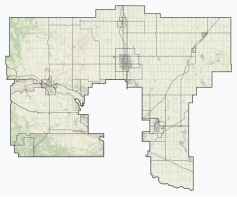
-In the 2011 Census, the Town of Cochrane had a population of 17,580 living in 6,523 of its 6,824 total dwellings, a 27.8% change from its 2006 population of 13,760. With a land area of 30.03 km2 (11.59 sq mi), it had a population density of 585.4/km2 (1,516.2/sq mi) in 2011.
III.ECONOMY
-In Cochrane, AB, the median household income is $113,500 per year.
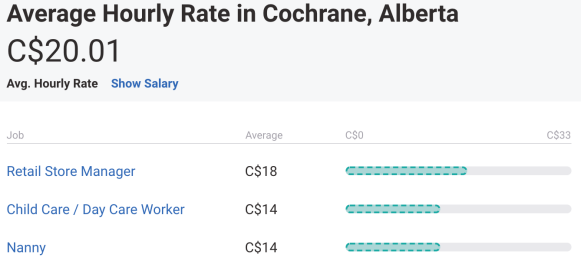
-Website: https://townfolio.co/ab/cochrane/demographics
IV.Industrial Characteristics
-2020-2030 Business Development Strategic Plan
Town Council showed their commitment to local business development and innovation by approving the 2020-30 Business Development Strategic Plan at their meeting Monday February 24, 2020.
The plan outlines four main business development strategies:
Proactively promote the innovation sector in the Town of Cochrane.
Proactively strengthen relationships with existing businesses groups, companies and major developers in Cochrane.
Proactively plan and implement initiatives to enhance Historic Downtown Cochrane.
Provide consultation and support for other Town initiatives, projects and processes that enhance Cochrane’s economic ecosystem.
2018-2023 Tourism Strategy
-Cochrane Dollars
Cochrane Business Development is a proud partner of Cochrane Dollars. Find out more about the local figures and landscapes featured on the bills, security features, and how you can use Cochrane’s local currency at CochraneDollar.ca.
-Business Development
Business development supports community economic growth through business attraction, retention programs, expansion and entrepreneur support. We attract economic investment to support and expand the existing business community.
-Economic Vision Statement for Cochrane
Create a vibrant, thriving and complete economy, where a wide variety of employment and business opportunities draw local, national and international talent, business and investors.
-Website: https://www.cochrane.ca/154/Business-Development
V.Attractions
1.Glenbow Ranch Provincial Park
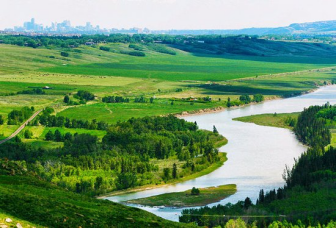
-Glenbow Ranch Provincial Park is a provincial park in the Calgary Region of Alberta, Canada. The majority of the park is located on the north bank of the Bow River within Rocky View County. Portions of the eastern and western extremeties of the park are located within the City of Calgary and the Town of Cochrane respectively.
-History
Plans to establish Glenbow Ranch Provincial Park began in 2006 when the children of Alberta rancher Neil Harvie sold 3,246 acres (1,314 ha) of land to the Government of Alberta for less than market value to conserve the land and protect it from development. Appraised at $67 million in 2005 and with an estimated value of $80 million in 2006, the land was sold to the province for $40 million and a $27 million charitable tax receipt. Under the deal, the Harvie family also established a $6 million foundation to promote and develop the park and Lois Hole Centennial Provincial Park near Edmonton.
Glenbow Ranch was officially designated as a provincial park by an order in council on April 17, 2008. The designation involved an additional 51 acres (21 ha) of land for a total of 3,297 acres (1,334 ha). The park officially opened to visitors on August 9, 2011.
-Email: experienceglenbow@grpf.ca
-Website: https://www.albertaparks.ca/parks/kananaskis/glenbow-ranch-pp/information-facilities/parks-contacts/glenbow-ranch-visitor-centre/
2.Cochrane Ranche Site
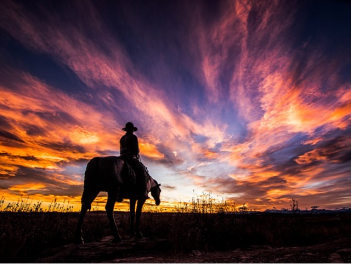
-Cochrane Ranche Site is a large community park (in a gorgeous natural setting) that’s steeped in western culture, Indigenous history, and numerous recreational opportunities, including family-friendly mountain biking trails. A few of the additional attractions in the park include: a quaint museum located in a historic 110-year-old building, a popular Farmer’s Market (every Saturday from June to September), a reconstructed corral, an interpretive trail that highlights the natural and human history of the site, picnic sites with fire pits, an outdoor stage for concerts and community events, the famous “Men of Vision” statue, archaeological remains, and of course, panoramic vistas of the aspen-coated foothills and soaring Rocky Mountains. Regardless of your interests, you’ll find something that is truly “your speed” in the 136-acre park.
-Address: 20 Bow Valley Trail, Cochrane, Alberta, T4C 2K8
-TEL: 1-403-828-8397
-Website:https://www.cochrane-tourism.ca/adventure-directory/historic-cochrane-ranche-site/?utm_source=TravelAlberta-ATIS&utm_medium=TravelAlberta&utm_campaign=ATIS+-+Alberta+Tourism+Information+Service&utm_content=Listing%2f10821%2fen-CA
3.Big Hill Springs Provincial Park
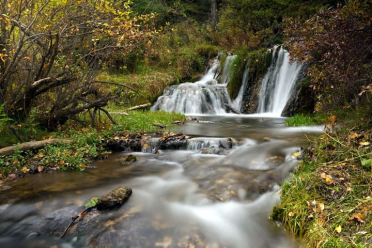
-Big Hill Springs Provincial Park is a provincial park in the foothills of Alberta's Rocky Mountains, about 40 kilometres (20 mi) northwest of Calgary, Alberta, Canada. It features a series of springs and small waterfalls that flow year-round over rocky terraces covered with a lush growth of mosses, shrubs, and grasses. The park also includes the ruins of an historic fish hatchery and Alberta's first commercial creamery. The main activities at the park are hiking, picnicking, scenic viewing, wildlife watching, and photography.
-Natural Setting
A series of springs feed the small stream that flows through the park, and its waterfalls flow across deposits of tufa that precipitated from the spring water. The springs and stream have consistently high year-round flow rates, which is probably why the old creamery and the fish hatchery were established there.
The spring water comes primarily from a layer of gravel, or sand and gravel, that was deposited by streams that flowed prior to the latest Wisconsin glaciation. The water issues from the contact between those sediments and the underlying bedrock, which is part of the late Paleocene Paskapoo Formation.
When the spring water reaches the surface, dissolved carbon dioxide is released and calcium carbonate precipitates, forming the tufa. The tufa tends to coat plant material such as mosses, twigs, and logs. Casts of plant material can sometimes be seen in the tufa if one looks closely.
The spring-fed stream flows into Big Hill Creek at the east end of the park, which in turn flows into the Bow River at Cochrane. The valley of Big Hill Creek was carved by meltwater flowing from retreating glaciers at the end of the Wisconsin glaciation. Big Hill Creek is now an underfit stream; that is, its current flow rate is not high enough to have carved the valley through which it flows.
-TEL: 403-297-5293
-Website: https://albertaparks.ca/parks/kananaskis/big-hill-springs-pp/?utm_source=TravelAlberta-ATIS&utm_medium=TravelAlberta&utm_campaign=ATIS+-+Alberta+Tourism+Information+Service&utm_content=Listing%2f5496%2fen-CA
VI.History
-Cochrane gets its name
Cochrane was named after Senator Matthew Henry Cochrane, the man who established the Cochrane Ranche in 1881. The Canadian Pacific Railway granted the town site in 1885 and named it in honour of Senator Cochrane, but few people made Cochrane their home despite the surrounding ranching population.
The little hamlet of Cochrane became a village in 1903 and in 1906 had a population of 158 residents. Five years later the village boasted a population of 395 residents.
-Before World War I
Before World War I, Cochrane was home to a stone quarry, a sawmill and four brick plants. Skilled artisans in the community combined their talents with local products to construct buildings of quality and individual style, giving Cochrane a unique and special character.
-Expansion & prosperity
The days of expansion and prosperity came to an end at the onset of World War I. The depression of 1913 caused serious problems in local industries and the shortage of manpower caused by the war sealed the fate of the town's industrial base. Many residents left Cochrane during the war years, but because it continued to act as the service centre for the rural population, the village was able to survive with a decreased but stable population of approximately 300.
It was not until after World War II that Cochrane began a renewed expansion, and in 1971, the community was incorporated as a town with a population exceeding 800.
-Economic boom
The general economic boom of the 1970s brought many new residents and a great burst of construction activity. As in most Alberta towns, the optimism and expansion of the early 1970s initiated a process of modernization which either demolished or resurfaced many of the older structures.
-Cochrane today
Today, Cochrane is still noted for its western heritage, unique buildings and popular Main Street, as well as its small town hospitality. With the completion of the downtown revitalization and celebration of the town's centennial in 2003, Cochrane has become a popular tourist attraction for many. The town has had a steadily increasing population over the last decade and the 2017 municipal census boasted an official population of 26,320 residents.
-Website: https://www.cochrane.ca/351/History-of-Cochrane
VII.Other information
-Cochrane Ranche provided the corral setting for the 1954 National Film Board of Canada documentary Corral, by Colin Low, whose father had worked as a foreman at the ranch. This film played theatrically across Canada and was named Best Documentary at the Venice Film Festival.
-Cochrane houses attractions such as Cochrane Ranche Historic Site and Bert Sheppard Stockmen's Foundation Library And Archives, located in the Cochrane Ranchehouse.
-Cochrane is home to many annual events each year:
Chamber of Commerce Trade Fair: Early May
Canada Day (July 1)
Cochrane and Area Events Society, with support from the Town of Cochrane presents the Canada Day Community Celebration: Canada Day (July 1)
Labour Day Rodeo & Parade: Labour Day weekend, the parade grows every year. In 2019 the parade had over 80 floats participate.
Terry Fox Run: September
Christmas Lightup: Late November
VIII.Contact information
-Government
Governing body: Cochrane Town Council
Mayor: Jeff Genung
-Contact Information
Address: 101 RancheHouse Road, Cochrane, AB T4C 2K8
Ph: 403-851-2500
Fax: 403-932-6032
-Website: https://www.cochrane.ca/directory.aspx
